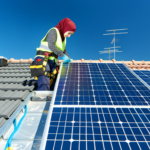Introduction
The Importance of Emergency Preparedness
In an increasingly unpredictable world, the importance of emergency preparedness cannot be overstated. Natural disasters, power outages, and other unforeseen events can disrupt daily life and pose significant risks to safety and well-being. Being prepared for such emergencies is crucial for ensuring the resilience and security of your home and family. Emergency preparedness involves having the right tools, supplies, and plans in place to handle various scenarios, from short-term power outages to long-term disruptions.
Why Solar Power?
When it comes to emergency power solutions, solar power stands out as a highly effective and sustainable option. Unlike traditional generators that rely on fossil fuels, solar power harnesses energy from the sun, making it a renewable and environmentally friendly choice. Solar power kits are particularly advantageous in emergencies for several reasons:
- Reliability: Solar panels can generate electricity as long as there is sunlight, providing a consistent power source even when the grid is down.
- Independence: Solar power systems operate independently of the power grid, ensuring that you have access to electricity even during widespread outages.
- Low Maintenance: Solar power systems require minimal maintenance compared to fuel-based generators, which need regular refueling and servicing.
- Quiet Operation: Solar power systems operate silently, unlike noisy generators, making them more suitable for residential areas.
Purpose of This Article
The purpose of this article is to provide a comprehensive review of emergency solar power kits, helping you make an informed decision when selecting the best kit for your needs. We will explore the components and types of solar power kits, key features to look for, and the benefits of using solar power in emergencies. Additionally, we will review some of the top emergency solar power kits available on the market and offer guidance on how to choose the right kit for your specific requirements. By the end of this article, you will have a clear understanding of how to build a resilient home with the help of emergency solar power kits.
Understanding Solar Power Kits
What is a Solar Power Kit?
A solar power kit is a comprehensive package that includes all the necessary components to harness solar energy and convert it into usable electricity. These kits are designed to be user-friendly, making it easier for individuals to set up their own solar power systems without needing extensive technical knowledge. Solar power kits are particularly useful for emergency preparedness, off-grid living, and remote locations where traditional power sources are unavailable or unreliable.
Components of a Solar Power Kit
A typical solar power kit includes several key components:
- Solar Panels: These are the primary components that capture sunlight and convert it into electrical energy. They come in various types, including monocrystalline, polycrystalline, and thin-film panels.
- Charge Controller: This device regulates the voltage and current coming from the solar panels to the batteries, preventing overcharging and ensuring optimal battery performance.
- Batteries: These store the electrical energy generated by the solar panels for later use. Common types include lead-acid and lithium-ion batteries.
- Inverter: This converts the direct current (DC) electricity stored in the batteries into alternating current (AC) electricity, which is used by most household appliances.
- Cables and Connectors: These are essential for connecting all the components of the solar power system.
- Mounting Hardware: This includes brackets and other hardware needed to securely install the solar panels.
Types of Solar Power Kits
Solar power kits come in various types, each designed to meet different needs and applications:
- Portable Solar Power Kits: These are compact and lightweight, making them ideal for camping, hiking, and other outdoor activities. They usually include foldable solar panels and small batteries.
- Residential Solar Power Kits: These are designed for home use and can power multiple household appliances. They typically include larger solar panels, more robust batteries, and higher-capacity inverters.
- Commercial Solar Power Kits: These are intended for businesses and larger installations. They come with high-capacity components to meet the energy demands of commercial operations.
- Off-Grid Solar Power Kits: These are designed for remote locations where there is no access to the power grid. They include all the necessary components to generate and store electricity independently.
- Grid-Tied Solar Power Kits: These are connected to the local power grid and can feed excess electricity back into the grid, often resulting in energy credits or reduced utility bills.
Understanding the different types and components of solar power kits is crucial for selecting the right system to meet your specific needs. Whether you’re preparing for emergencies, looking to reduce your carbon footprint, or seeking energy independence, there’s a solar power kit designed to help you achieve your goals.
Key Features to Look for in Emergency Solar Power Kits
When selecting an emergency solar power kit, it’s essential to consider several key features to ensure you get the most reliable and efficient system for your needs. Below are the critical aspects to look for:
Portability and Size
One of the primary considerations for an emergency solar power kit is its portability and size. In emergency situations, you may need to move the kit quickly or transport it to different locations. Look for kits that are compact and lightweight, making them easy to carry and store. Foldable solar panels and units with built-in handles or wheels can significantly enhance portability. For instance, a kit that can fit in the trunk of a car or be carried by hand is ideal for quick evacuations or camping trips.
Power Output and Storage Capacity
The power output and storage capacity of the solar power kit are crucial for determining how many devices and appliances you can run and for how long. Power output is usually measured in watts (W), while storage capacity is measured in watt-hours (Wh) or ampere-hours (Ah). Assess your power needs by listing the devices you plan to use and their power requirements. For example, a kit with a 500W inverter and a 1000Wh battery can power small appliances like lights, a mini-fridge, and charge multiple gadgets. Ensure the kit can handle peak power demands and has sufficient storage to last through the night or during cloudy days.
Durability and Weather Resistance
Durability and weather resistance are vital features, especially if you plan to use the kit outdoors or in harsh conditions. Look for kits with rugged, weatherproof components that can withstand rain, wind, and extreme temperatures. High-quality materials like corrosion-resistant aluminum frames for solar panels and robust, waterproof casings for batteries and inverters are essential. Some kits also come with built-in protective features like overcharge and short-circuit protection, which enhance the system’s longevity and reliability.
Ease of Use and Setup
In an emergency, you need a solar power kit that is easy to set up and use without requiring technical expertise. Kits with plug-and-play components, clear instructions, and minimal assembly are ideal. Features like pre-wired connections, intuitive interfaces, and quick-connect ports can make the setup process straightforward. Additionally, some kits come with mobile apps or digital displays that provide real-time monitoring and control, making it easier to manage your power usage.
Additional Features (e.g., USB ports, inverters)
Additional features can significantly enhance the functionality and convenience of your solar power kit. Look for kits that include multiple USB ports for charging smartphones and tablets, AC outlets for running household appliances, and DC ports for other devices. An integrated inverter is essential for converting DC power from the solar panels to AC power for most household appliances. Some advanced kits also offer features like built-in LED lights, solar charge controllers with MPPT (Maximum Power Point Tracking) for efficient charging, and expandable battery options for increased capacity.
By considering these key features, you can select an emergency solar power kit that meets your specific needs and provides reliable power during emergencies.
Benefits of Using Solar Power Kits for Emergencies
Sustainability and Environmental Impact
Solar power kits offer a sustainable and environmentally friendly solution for emergency power needs. Unlike traditional generators that rely on fossil fuels, solar power harnesses energy from the sun, a renewable resource. This reduces greenhouse gas emissions and minimizes the carbon footprint. By using solar power kits, you contribute to a cleaner environment and help combat climate change. Additionally, solar energy systems produce no noise pollution, making them a more pleasant option for residential areas during emergencies.
Cost-Effectiveness Over Time
While the initial investment in solar power kits can be significant, they prove to be cost-effective in the long run. Traditional generators require ongoing fuel purchases and maintenance, which can add up over time. In contrast, solar power kits have minimal operational costs once installed. The sun’s energy is free, and modern solar panels are designed to last for decades with little maintenance. Over time, the savings on fuel and maintenance can offset the initial cost, making solar power kits a financially sound investment for emergency preparedness.
Independence from the Power Grid
One of the most significant advantages of solar power kits is their ability to operate independently from the power grid. During natural disasters or widespread power outages, the grid can be unreliable or completely unavailable. Solar power kits provide a self-sufficient energy source, ensuring that you have access to electricity when you need it most. This independence is crucial for maintaining essential services such as lighting, refrigeration, and communication devices during emergencies. With a solar power kit, you can be confident that you won’t be left in the dark when the grid goes down.
Versatility for Various Situations
Solar power kits are incredibly versatile and can be used in a wide range of emergency scenarios. Whether you’re dealing with a short-term power outage or a prolonged disaster, solar power kits can provide the necessary energy to keep your household running. They are suitable for various applications, from powering small devices like phones and laptops to running larger appliances such as refrigerators and medical equipment. Portable solar power kits can also be easily transported and set up in different locations, making them ideal for use in emergency shelters or remote areas. This versatility ensures that you are prepared for any situation that may arise.
Top Emergency Solar Power Kits Reviewed
Kit 1: Overview and Features
Goal Zero Yeti 400 Portable Power Station
The Goal Zero Yeti 400 is a versatile and reliable solar power kit designed for emergency situations. It features a 396Wh lead-acid battery, which can be charged via solar panels, AC outlet, or car charger. The kit includes multiple output ports, including USB, 12V, and AC, making it suitable for powering a variety of devices.
- Battery Capacity: 396Wh
- Power Output: 300W continuous, 600W surge
- Ports: 2 USB ports, 2 AC outlets, 3 12V ports
- Weight: 29 lbs
- Additional Features: LCD display for monitoring battery status, chainable with other Yeti units for increased capacity
Kit 2: Overview and Features
Jackery Explorer 500 Portable Power Station
The Jackery Explorer 500 is a compact and lightweight solar power kit ideal for emergency preparedness. It comes with a 518Wh lithium-ion battery and can be charged using solar panels, an AC outlet, or a car charger. The kit includes multiple output options, making it versatile for various emergency needs.
- Battery Capacity: 518Wh
- Power Output: 500W continuous, 1000W surge
- Ports: 3 USB ports, 1 AC outlet, 2 12V ports
- Weight: 13.32 lbs
- Additional Features: LCD screen for real-time battery status, built-in LED flashlight
Kit 3: Overview and Features
Renogy Phoenix 300 Portable Power Station
The Renogy Phoenix 300 is a highly portable and efficient solar power kit designed for emergency use. It features a 337Wh lithium-ion battery and can be charged via solar panels, AC outlet, or car charger. The kit is equipped with multiple output ports, making it suitable for a range of devices.
- Battery Capacity: 337Wh
- Power Output: 300W continuous, 600W surge
- Ports: 2 USB ports, 1 AC outlet, 2 12V ports
- Weight: 6.4 lbs
- Additional Features: LCD display for monitoring, built-in LED flashlight, compact design
Kit 4: Overview and Features
EcoFlow River 600 Portable Power Station
The EcoFlow River 600 is a robust and versatile solar power kit perfect for emergency situations. It comes with a 288Wh lithium-ion battery and can be charged using solar panels, an AC outlet, or a car charger. The kit includes a variety of output ports, making it highly adaptable for different needs.
- Battery Capacity: 288Wh
- Power Output: 600W continuous, 1200W surge
- Ports: 3 USB ports, 3 AC outlets, 2 12V ports
- Weight: 11 lbs
- Additional Features: LCD screen for real-time monitoring, modular design for expandable capacity
Kit 5: Overview and Features
Rockpals 300W Portable Power Station
The Rockpals 300W is a reliable and affordable solar power kit designed for emergency use. It features a 280Wh lithium-ion battery and can be charged via solar panels, an AC outlet, or a car charger. The kit includes multiple output ports, making it versatile for various emergency scenarios.
- Battery Capacity: 280Wh
- Power Output: 300W continuous, 600W surge
- Ports: 4 USB ports, 1 AC outlet, 2 12V ports
- Weight: 7.3 lbs
- Additional Features: LCD display for battery status, built-in LED flashlight, compact and lightweight design
How to Choose the Right Solar Power Kit for Your Needs
Assessing Your Power Needs
Before purchasing a solar power kit, it’s crucial to evaluate your power requirements. Start by listing all the devices and appliances you plan to power during an emergency. Calculate their total wattage and consider how long you will need to run them. For instance, if you need to power a refrigerator (800W), a few LED lights (20W each), and charge mobile devices (10W each), you must ensure your solar power kit can handle this load. **Tip:** Always add a 20% buffer to your total wattage to account for inefficiencies and unexpected power needs.
Considering Your Environment and Usage
Your environment plays a significant role in determining the type of solar power kit you need. If you live in an area with abundant sunlight, a kit with a smaller battery and fewer solar panels might suffice. Conversely, in regions with frequent cloudy weather, you may need a larger battery and more efficient panels to ensure consistent power. Additionally, consider how you will use the kit. For instance, if you need a portable solution for camping or travel, prioritize lightweight and compact designs. For home use, a more robust, stationary system might be more appropriate.
Budget Considerations
Solar power kits come in a wide range of prices, from a few hundred to several thousand dollars. Determine your budget by balancing your power needs with what you can afford. While higher-end kits offer more features and greater reliability, there are cost-effective options that can still meet basic needs. **Remember:** Investing in a quality kit can save money in the long run by reducing reliance on the grid and lowering electricity bills. Look for kits that offer good warranties and customer support, as these can be indicators of a reliable product.
Reading Reviews and Seeking Recommendations
Before making a purchase, read reviews from other users to gauge the performance and reliability of different solar power kits. Look for reviews that mention the kit’s ease of setup, durability, and actual power output compared to the manufacturer’s claims. Additionally, seek recommendations from friends, family, or online communities who have experience with solar power kits. **Pro Tip:** Pay attention to reviews that discuss long-term usage, as these can provide insights into the kit’s durability and performance over time.
By carefully assessing your power needs, considering your environment and usage, setting a realistic budget, and reading reviews, you can choose the right solar power kit to ensure your home remains resilient during emergencies.
Conclusion
Recap of Key Points
In this article, we have explored the critical aspects of building a resilient home with emergency solar power kits. We began by discussing the importance of emergency preparedness and why solar power is an excellent choice for such scenarios. We then delved into understanding solar power kits, including their components and types. Key features to look for in these kits were highlighted, such as portability, power output, durability, and additional functionalities. The benefits of using solar power kits for emergencies were also discussed, emphasizing sustainability, cost-effectiveness, independence from the power grid, and versatility. We reviewed some of the top emergency solar power kits available in the market and provided guidance on how to choose the right kit for your needs.
Final Thoughts on Building a Resilient Home
Building a resilient home is not just about having a sturdy structure; it’s about ensuring that you and your family can maintain a semblance of normalcy during emergencies. Solar power kits play a pivotal role in this by providing a reliable and sustainable source of energy when traditional power sources fail. The increasing frequency of extreme weather events and the growing strain on our electrical grids make it imperative to invest in solutions that offer both immediate relief and long-term benefits. By integrating solar power kits into your emergency preparedness plan, you are taking a significant step towards self-sufficiency and resilience.
Encouragement to Take Action
Now is the time to take action. The unpredictability of natural disasters and power outages means that preparation cannot be postponed. Evaluate your power needs, consider your environment, and set a budget to find the most suitable solar power kit for your home. Read reviews, seek recommendations, and make an informed decision. Investing in an emergency solar power kit is not just a purchase; it’s a commitment to safety, sustainability, and peace of mind. Equip your home with the tools it needs to withstand emergencies and ensure that you and your loved ones are never left in the dark.






